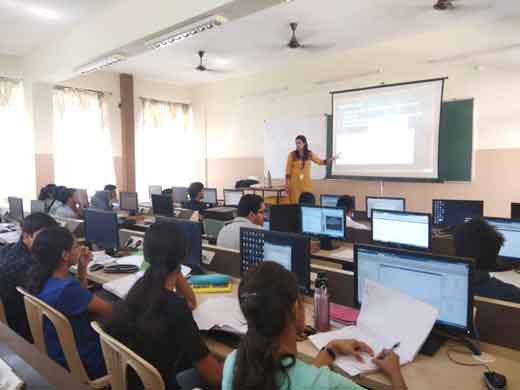Workshop on “ANALYSIS AND SIMULATION OF CONTROL SYSTEMS USING MATLAB”
The Department of Electronics and Telecommunication Engineering in association with DBEATS organized a one day workshop on “Analysis and Simulation of Control Systems using MATLAB” on 28th October 2017. The workshop was organized for the Third year ETC students and the resource persons for the workshop were Prof. Anisha Cotta and Mr. Zain Rajani.

The workshop commenced at 9.30 am with an introduction to stability of control systems using Root Locus technique. In control theory and stability theory, root locus analysis is a graphical method for examining how the roots of a system change with variation of a certain system parameter, commonly a gain within a feedback system. The root locus plots of the poles and zeroes of the closed loop transfer function in the complex s-plane were analysed in Matlab. Control systems were simulated using Matlab and its stability was determined by using the Root Locus technique. Following the root locus technique, the students were introduced to Bode Plot which is a useful tool that shows the gain and phase response of a given LTI system for different frequencies. Bode Plots are generally used with the Fourier Transform of a given system time domain analysis and Matlab was used to demonstrate Bode plots and for determination of gain margin and phase margin.
The next session was based on determination and analysis of time domain specifications using Matlab. The session included finding the time domain response for various types of standard input signals. Second order systems with different types of damping ratios were demonstrated using Matlab. Time domain specifications of control sytems such as rise time, fall time, peak time, settling time etc were implemented theoretically and were verified practically using Matlab.
The afternoon session was based on the design and analysis of compensating networks in the control system. Lead, lag and lead- lag networks were introduced and their typical uses were discussed. Matlab was used to design the different compensators. Analysis of the lead, lag and lead- lag networks was also done using Matlab. Given the control plant, the desired specifications were achieved using compensators PI, PD, and PID, and optimizing controllers were used to improve system parameters such as reducing steady state error, reducing resonant peak, improving system response by reducing rise time. Around 50 students from T.E ETC attended the workshop and showed keen interest in all the topics that were covered.












 Visit Today : 1040
Visit Today : 1040